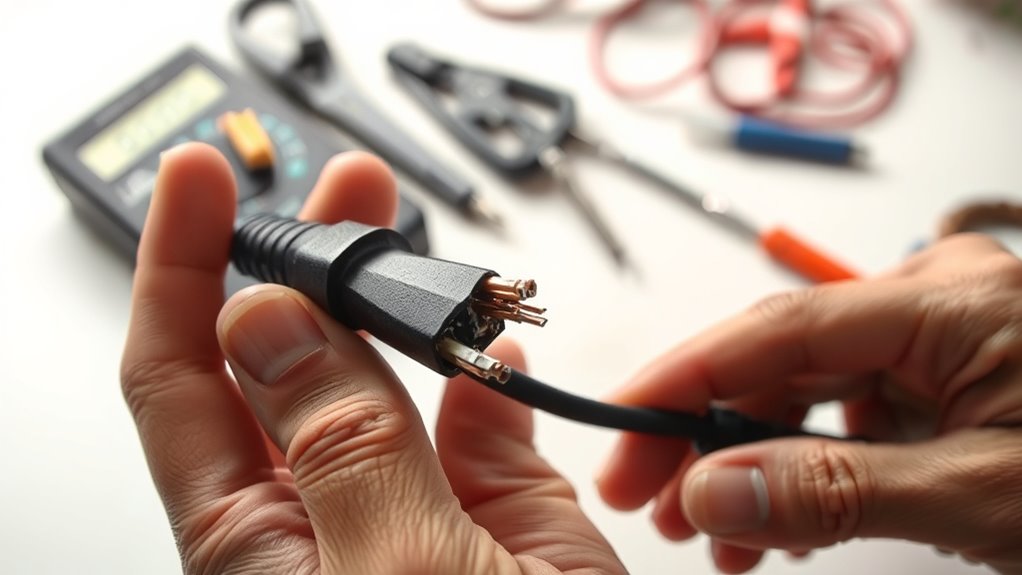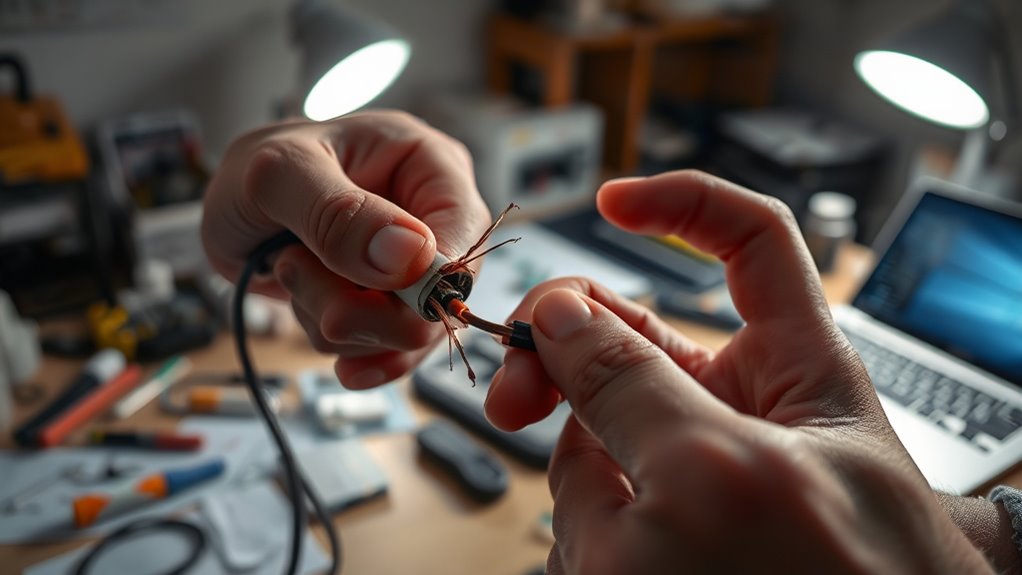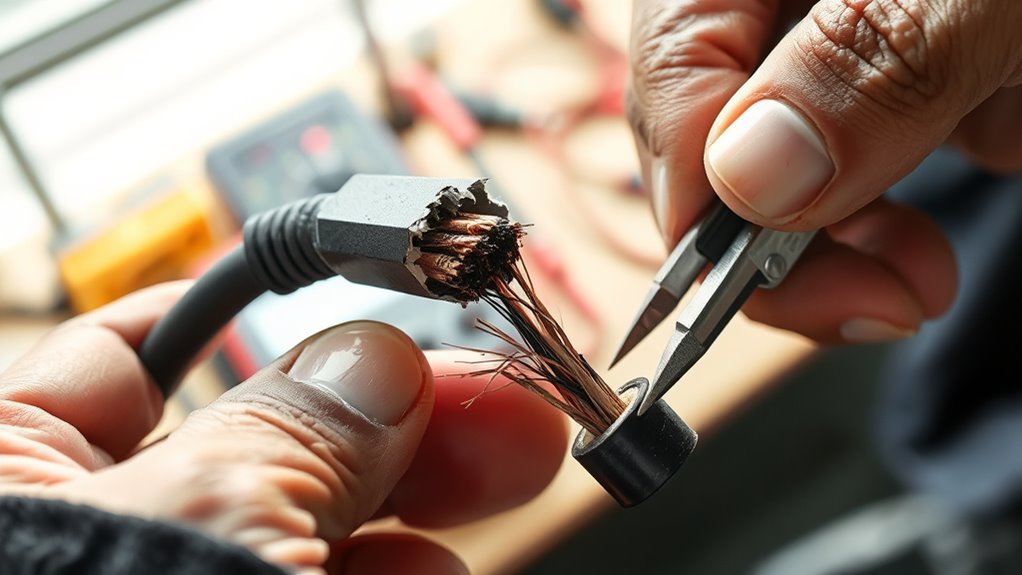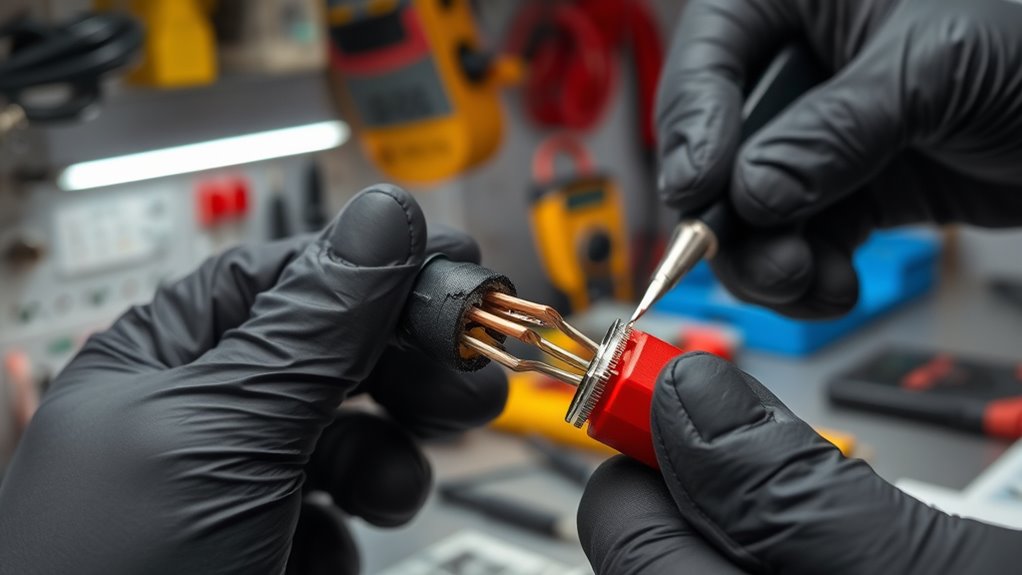To rewire a damaged power cord, first unplug it and inspect for visible damage like frayed wires or burns. Gather tools such as wire cutters, screwdrivers, and replacement wire. Carefully remove the damaged section, then strip insulation from the new wire ends. Twist and secure the wires with connectors or electrical tape. Before plugging it back in, test the connection with a multimeter to guarantee safety. Keep going for detailed steps to do it right.
Key Takeaways
- Identify and assess the extent of damage to the power cord before beginning repairs.
- Unplug the cord, then carefully remove the damaged section using wire cutters.
- Strip about half an inch of insulation from each wire end for proper connection.
- Twist new wiring securely to existing wires and insulate with wire connectors or electrical tape.
- Test the repaired cord with a multimeter to ensure proper continuity and safety before use.
Identifying the Damage and Gathering Necessary Tools

Before you begin rewiring a damaged power cord, it’s essential to identify the problem area and gather the right tools. Start by inspecting the cord carefully for visible damage like frayed wires, cracks, or burns. Use safety precautions, such as unplugging the cord and wearing insulated gloves, to prevent electric shock. Once you locate the damage, gather suitable tools like wire cutters, screwdrivers, replacement wire, and electrical tape. Having the right tools ensures you can safely remove damaged sections and make secure connections. Confirm that your tools are in good condition and rated for electrical work. Taking these steps minimizes risks and sets a solid foundation for a safe, effective repair. Proper identification and preparation are key to a successful rewiring process, including understanding the electrical safety measures necessary when working with power cords.
Unplugging and Preparing Your Workspace

To start safely rewiring your power cord, you need to unplug it from the power source first. This is a vital safety precaution to prevent electrical shocks. Before you begin, clear your workspace of clutter to avoid accidents and guarantee easy access to tools. Organize your tools and materials nearby so you’re not searching during the process. Make sure your work surface is dry and stable, reducing the risk of slips or shorts. Use proper lighting to see clearly and avoid mistakes. Keep children and pets away to maintain a safe environment. Taking these steps helps you stay focused and minimizes hazards, guaranteeing you can rewire your power cord efficiently and safely. Proper workspace organization and safety precautions are key to a successful repair. Additionally, maintaining a well-organized workspace can boost your overall productivity and reduce stress during the task.
Removing the Damaged Section of the Cord

Carefully examine the damaged section of the cord to determine the extent of the damage. Safety precautions are essential; unplug the cord and wear insulated gloves to prevent shocks. Use wire cutters to carefully remove the compromised portion, ensuring you cut beyond any frayed or burnt areas. Avoid pulling or tearing the cord, which could cause further damage or expose internal wires. If the damage is minor, consider alternative repair methods like splice connectors or electrical tape, but only if you’re confident in your skills. For extensive damage, removing the entire compromised section is safer and more reliable. Remember, taking your time and working carefully minimizes risks and prepares the cord for proper reassembly. Additionally, understanding the benefits of easy cleanup with water-based paints can help you plan safer and more efficient repair procedures.
Connecting and Securing the New Wiring

Once you’ve removed the damaged section of the cord, it’s time to connect and secure the new wiring properly. Start by stripping about half an inch of insulation from each wire end using wire strippers. This process, called insulation stripping, exposes clean metal conductors for a solid connection. Next, carefully splice the new wires to the existing ones, twisting the exposed conductors together tightly. For added security and safety, consider using wire connectors or electrical tape to insulate and secure the spliced connections. Make sure all splices are tight and well-insulated to prevent any loose contacts or short circuits. Properly securing your wiring ensures a reliable connection and reduces the risk of future damage or electrical hazards. Additionally, understanding all waterparks can help you plan safe and enjoyable activities if you’re doing electrical work near water or in humid environments.
Testing the Repaired Power Cord Safely

Before plugging in your repaired power cord, it’s essential to test it thoroughly to guarantee safety and proper function. Follow safety precautions by inspecting the cord for any visible damage or exposed wires before testing. Use a multimeter to check for continuity, ensuring the wiring connections are solid and no breaks exist. Confirm that the insulation is intact and that there’s no risk of short circuits. When performing testing procedures, avoid plugging the cord into a power source until you’re confident it’s safe. Always use a grounded outlet and keep the area dry. If any irregularities arise during testing, recheck your connections or consult a professional. Proper testing ensures your repaired power cord is safe to use and prevents potential hazards. Additionally, understanding headphone compatibility can help prevent electrical issues if you plan to use the cord with audio devices.
Frequently Asked Questions
Can I Rewire a Power Cord for Any Electronic Device?
You can rewire a power cord for many electronic devices, but you must prioritize electrical safety. Make sure you understand proper rewiring techniques and follow safety guidelines to avoid hazards. Always disconnect the device from power before starting, use the right tools, and check for damage. If you’re unsure or inexperienced, it’s best to consult a professional. Proper wiring ensures your device works safely and reliably.
What Safety Precautions Should I Take During Rewiring?
Coincidentally, safety first is vital whenever you handle electrical projects. You should always unplug the device before rewiring to avoid electrical shock. Wear insulated gloves and use tools with insulated handles. Work in a dry, well-ventilated area to prevent fire hazards. Keep a fire extinguisher nearby, and double-check connections before powering up. These precautions make sure you stay safe and prevent potential electrical shock or fire hazards during rewiring.
How Long Does a Typical Power Cord Repair Last?
When considering how long a power cord repair lasts, you’ll want to think about its durability estimate and repair longevity. Generally, a well-done repair can last several years if you use quality materials and follow proper techniques. However, the lifespan varies depending on the cord’s usage, handling, and the repair method. Regularly inspecting the cord will help guarantee it remains safe and functional over time.
Is It Better to Replace or Repair a Damaged Power Cord?
If you’re facing a damaged power cord, choosing whether to repair or replace feels like deciding between a band-aid and a new life. Repairing might save money upfront, but a replacement often costs less in the long run and reduces environmental impact, making it the smarter choice. A cost comparison shows replacements are usually more reliable, preventing hazards and ensuring safety. Don’t risk it—sometimes, starting fresh is the best move.
Can I Rewire a Power Cord Without Professional Tools?
You can rewire a power cord without professional tools, but DIY safety is essential. Use basic electrical tools like wire strippers and screwdrivers, making sure you work in a dry area away from water. Carefully follow wiring diagrams and always unplug the device before starting. If you’re unsure or uncomfortable, it’s safer to seek professional help. Proper tools and safety precautions prevent accidents and guarantee a reliable, long-lasting repair.
Conclusion
With your repair complete, your power cord is ready to serve like a phoenix rising from the ashes. Just as Daedalus crafted wings to reach new heights, you’ve rewired with care and precision. Remember, safety is your guiding star—test thoroughly and use your restored cord wisely. Like a well-tuned instrument, your device now hums with renewed life. Trust your work, and let this small act of repair remind you of your own resourceful strength.









